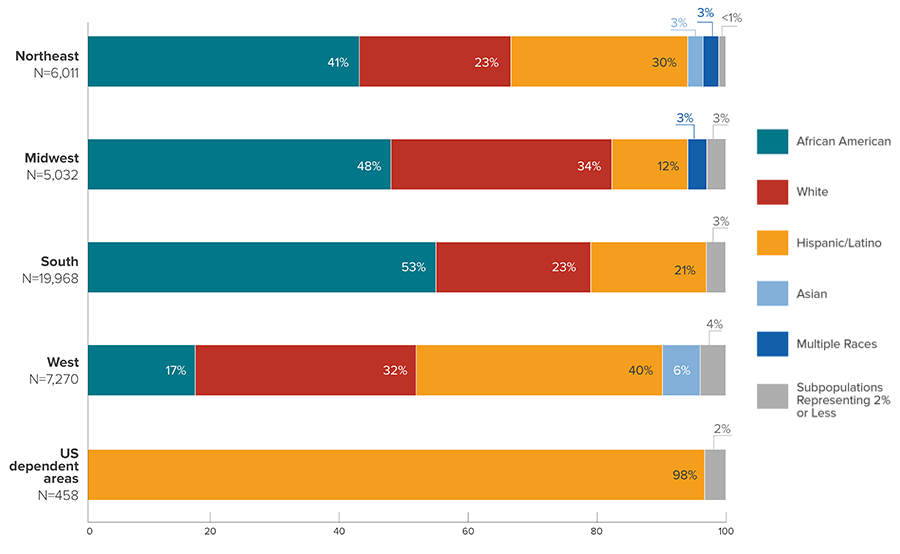HIV in the United States by Region
In the United States (US),a HIV diagnosesb are not evenly distributed across states and regions.c Southern states accounted for more than half of the 38,739 new HIV diagnoses in 2017.
Overall, in the 50 states and the District of Columbia only, the majority of people who receive an HIV diagnosis live in urban areas. But in the South, 23% of new HIV diagnoses are in suburban and rural areas, and in the Midwest 21% are suburban or rural—higher proportions than in the Northeast and West. The South’s larger and more geographically dispersed population of people living with HIV creates unique challenges for prevention and treatment.
Understanding the places and populations that are most affected by HIV allows the federal government to allocate its resources to the geographic areas where they are needed most, while still supporting a basic level of HIV education and prevention for everyone across the country.
The Numbers
HIV Diagnoses
In 2017:
- The South made up 52% (19,968) of the new HIV diagnoses in the US, followed by the West (7,270; 19%), the Northeast (6,011; 16%), and the Midwest (5,032; 13%). US dependent areas made up 458 (1%) of new HIV diagnoses.
- The rates (per 100,000 people) of HIV diagnoses were 16.1 in the South, 12.3 in the US dependent areas, 10.6 in the Northeast, 9.4 in the West, and 7.4 in the Midwest.
From 2012 to 2016:
HIV diagnoses remained stable in the US, although some decreases were seen in regions with fewer diagnoses.
- US dependent areas: Decreased 27%.
- Northeast: Decreased 17%.
- Midwest: Decreased 6%.
- South: Remained stable.
- West: Remained stable.
Rates of HIV Diagnoses in the US, 2017

Source: CDC. Diagnoses of HIV infection in the United States and dependent areas, 2017 HIV Surveillance Report 2018;29.
New Diagnoses in the US by Race/Ethnicity and Region of Residence, 2017

Subpopulations representing 2% or less of all people who received an HIV diagnosis in 2017 are combined in this chart.
Source: CDC. Diagnoses of HIV infection in the United States and dependent areas, 2017. HIV Surveillance Report 2018;29.
Living With HIV
In the 50 states and the District of Columbia only:
- Southern states accounted for approximately 46% of all people with HIV at the end of 2015.d States reporting the highest rates of people with HIV are predominantly in the South and the Northeast.
- An estimated 86% (960,351) of people were aware of their infection at the end of 2015. But in 12 out of 17 Southern states, the estimated percentage of people aware of their infection was lower than the national estimate.
At the end of 2016, the overall prevalence of people with diagnosed HIV in the US was 308.3 per 100,000 people. By region, prevalence was 459.2 in the US dependent areas, 418.8 in the Northeast, 361.3 in the South, 253.7 in the West, and 174.5 in the Midwest.
Knowledge of HIV status and the health of people with HIV vary widely across the US, with Southern states generally behind other regions in some key HIV prevention and care indicators.
In 39 states and the District of Columbia:
- Among people with diagnosed HIV in 2015, 73% received some HIV medical care, 57% were retained in HIV care, and 60% had a suppressed viral load.e,f Half of the states that had the lowest percentages of people who received HIV medical care and had a suppressed viral load were in the South.
Deaths
In 2016, there were 15,807 deaths among people with diagnosed HIV in the US. Nearly half (47%) of these deaths were in the South; 3,630 (23%) were in the Northeast; 2,604 (16%) were in the West; 1,720 (11%) were in the Midwest; and 379 (2%) were in the US dependent areas. These deaths may be due to any cause.
a Unless otherwise noted, the term United States (US) includes the 50 states, the District of Columbia, and the 6 dependent areas of American Samoa, Guam, the Northern Mariana Islands, Puerto Rico, the Republic of Palau, and the US Virgin Islands.
b HIV diagnoses refers to the number of people who received a diagnosis of HIV during a given period of time, not when the people were infected.
c Regions used in CDC’s National HIV Surveillance System:
Northeast: CT, ME, MA, NH, NJ, NY, PA, RI, VT
Midwest: IL, IN, IA, KS, MI, MN, MO, NE, ND, OH, SD, WI
South: AL, AR, DE, DC, FL, GA, KY, LA, MD, MS, NC, OK, SC, TN, TX, VA, WV
West: AK, AZ, CA, CO, HI, ID, MT, NV, NM, OR, UT, WA, WY.
d Includes diagnosed and undiagnosed HIV infections among adults and adolescents.
e Among adults and adolescents with diagnosed HIV.
f People are considered retained in care if they get two viral load or CD4 tests at least 3 months apart in a year. (CD4 cells are the cells in the body’s immune system that are destroyed by HIV.) Viral suppression is based on the most recent viral load test.
Bibliography
- CDC. Diagnoses of HIV infection in the United States and dependent areas, 2017. HIV Surveillance Report 2018;29.
- CDC. Estimated HIV incidence and prevalence in the United States, 2010-2015. HIV Surveillance Supplemental Report 2018;23(1).
- CDC. Monitoring selected national HIV prevention and care objectives by using HIV surveillance data—United States and 6 dependent areas—2015. HIV Surveillance Supplemental Report 2017;22(2).
- CDC. Selected national HIV prevention and care outcomes (slides).
- CDC. HIV surveillance in urban and nonurban areas through 2017 (slides).
Additional Resources
- CDC-INFO 1-800-CDC-INFO (232-4636)
- CDC HIV Website
- CDC Act Against AIDS Campaign
- CDC HIV Risk Reduction Tool (BETA)
- Page last reviewed: November 27, 2018
- Page last updated: November 27, 2018
- Content source: Division of HIV/AIDS Prevention, National Center for HIV/AIDS, Viral Hepatitis, STD, and TB Prevention, Centers for Disease Control and Prevention


 ShareCompartir
ShareCompartir

